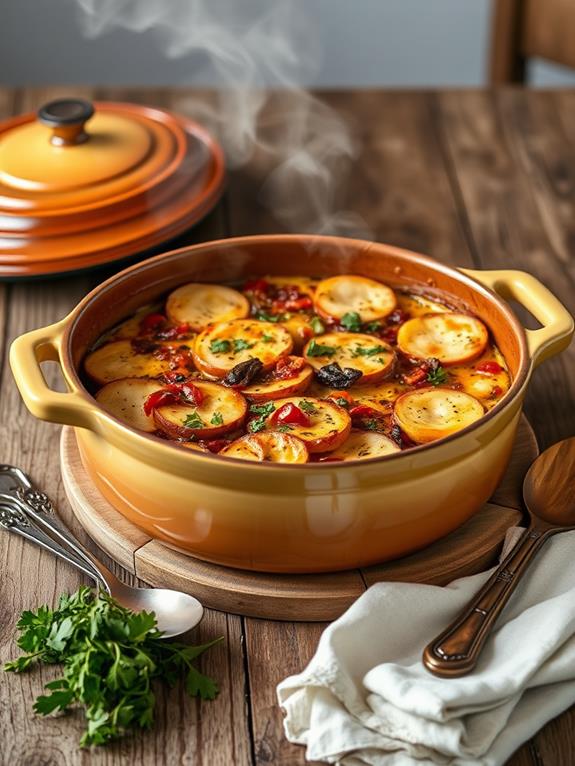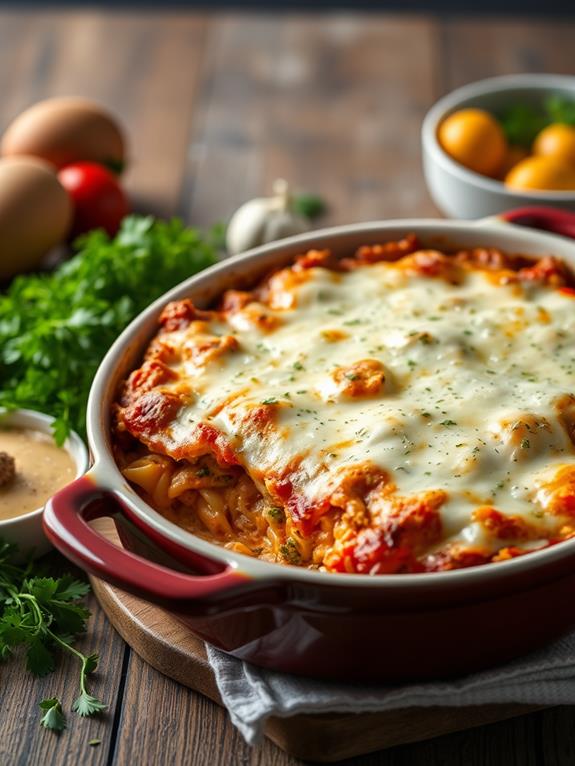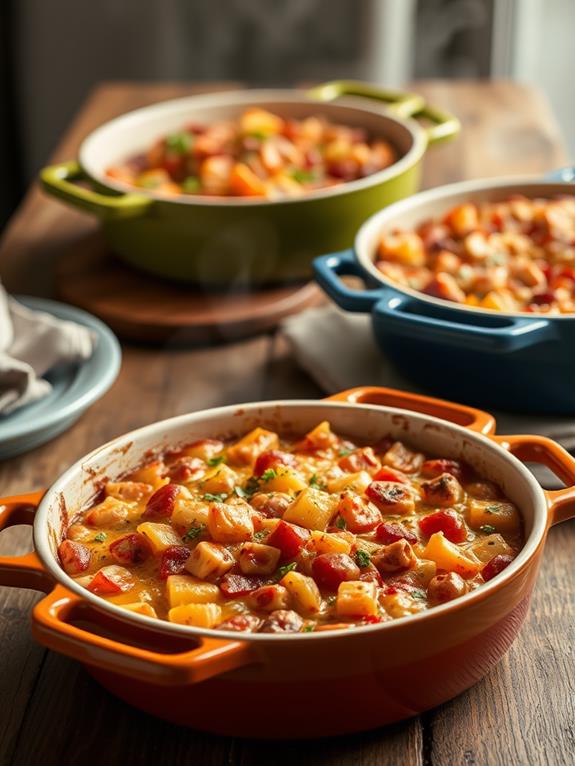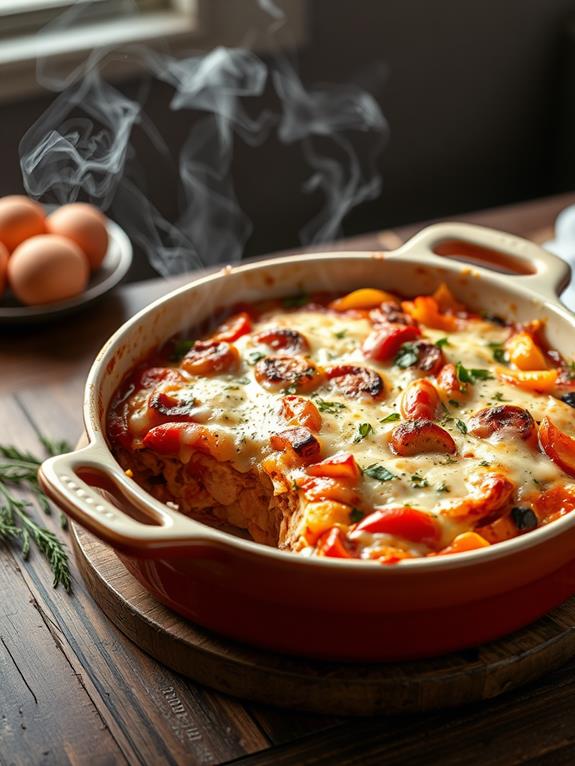What Is a Casserole
A casserole is a one-dish meal that combines protein, vegetables, and starch in a deep baking dish. You'll typically find it bound with a sauce or liquid, creating a cohesive and flavorful dish. The term originates from the French word for saucepan, but the concept dates back to ancient civilizations. Casseroles gained popularity during the Great Depression and World War II due to their frugality. They're versatile, allowing you to layer ingredients, precook certain items, and adapt recipes to various dietary needs. From green bean casserole to moussaka, these dishes reflect regional cuisines and cultural traditions. Exploring casseroles further reveals a world of culinary possibilities and cooking techniques.
This post may contain affiliate links. If you make a purchase through these links, I may earn a commission at no additional cost to you. Additionally, portions of this post may be generated using artificial intelligence (AI) technology. While we strive for accuracy, please be aware that AI-generated content may not always be perfect and should be fact-checked when necessary.
The Spatula Scoops
- A casserole is a one-dish meal cooked in a deep baking dish, combining protein, vegetables, and starch.
- The term "casserole" comes from the French word for saucepan, with the concept dating back to ancient civilizations.
- Key components include a starch base, protein source, vegetables, and a binding agent like sauce or cream.
- Casseroles gained popularity during the Great Depression and World War II for their frugality and convenience.
- Popular types include Green Bean Casserole, Moussaka, and Pastel de Choclo, reflecting various regional cuisines and traditions.
Definition and Origin

For centuries, casseroles have been a staple in kitchens around the world. You've probably enjoyed this versatile dish without fully understanding its definition or origins. A casserole is a one-dish meal cooked and served in a deep, wide baking dish. It typically combines protein, vegetables, and a starch, often bound together with a sauce or liquid.
The term "casserole" comes from the French word for saucepan, but its concept dates back to ancient civilizations. You'll find early versions in medieval European cookbooks, where they were called "hot pots." The modern casserole gained popularity in the 20th century, particularly during the Great Depression and World War II, when frugal, one-dish meals were essential.
Today, casseroles remain a popular choice for their convenience and versatility. They're often used in "batch cooking," a meal preparation technique where you cook large quantities at once. This approach can improve your website's SEO by providing relevant content for long-tail keywords related to meal planning and time-saving recipes. Remember, casseroles aren't just comfort food; they're a culinary tradition with a rich history.
Key Components of Casseroles

Casseroles are like culinary puzzles, with each piece playing an essential role in the final dish. You'll find that most casseroles share key components that contribute to their comforting nature and ease of preparation. The base typically consists of a starch, such as rice, pasta, or potatoes, which provides substance and absorbs flavors. You'll often include a protein source, like meat, poultry, or beans, to make the dish more filling and nutritious.
Vegetables are fundamental in casseroles, adding color, texture, and nutrients. You'll want to choose vegetables that complement your other ingredients and hold up well during baking. A binding agent, usually a sauce or cream-based mixture, helps to unify the components and create a cohesive dish. This could be a béchamel sauce, cream of mushroom soup, or even beaten eggs.
Popular Types of Casseroles

Around the world, you'll find a diverse array of beloved casserole recipes that have stood the test of time. These hearty dishes often reflect regional cuisines and cultural traditions. Let's explore some popular types of casseroles you might encounter:
| Region | Casserole Type | Main Ingredients | Unique Feature |
|---|---|---|---|
| North America | Green Bean Casserole | Green beans, mushroom soup | Crispy onion topping |
| Mediterranean | Moussaka | Eggplant, ground meat, béchamel | Layered structure |
| Latin America | Pastel de Choclo | Corn, beef, chicken | Sweet corn crust |
| Asia | Bibimbap | Rice, vegetables, meat | Served in a hot stone bowl |
You'll notice that each casserole has its distinct characteristics. Green bean casserole, a Thanksgiving staple in the U.S., combines creamy textures with a crunchy topping. Moussaka, popular in Greece, features layers of eggplant and meat topped with a rich béchamel sauce. Pastel de choclo from Chile blends savory and sweet flavors, while bibimbap, though not traditionally baked, shares the one-dish concept with a vibrant mix of ingredients. These diverse casseroles showcase how versatile and adaptable the concept is across different cultures.
Cooking Techniques and Tips

Mastering a few key cooking techniques can elevate your casserole game from good to great. Start by properly layering your ingredients, guaranteeing even distribution and balanced flavors throughout. You'll want to precook certain items, like meats and some vegetables, to ensure they're fully cooked and to prevent excess moisture in your final dish.
When it comes to baking, cover your casserole with foil for the first part of cooking to prevent over-browning, then remove it for the final 15-20 minutes to achieve that desirable golden crust. Don't forget to let your casserole rest for 10-15 minutes after baking; this allows the flavors to meld and makes serving easier.
For creamy casseroles, create a roux as your base. This mixture of fat and flour will thicken your sauce beautifully. If you're using pasta, slightly undercook it before adding to the casserole, as it'll continue to cook in the oven. Finally, consider your dish's texture. Adding a crunchy topping, like breadcrumbs or crushed crackers, can provide a pleasant contrast to softer ingredients.
Nutritional Benefits and Variations

While often associated with comfort food, casseroles can actually be quite nutritious when prepared thoughtfully. You can boost their health benefits by incorporating lean proteins, whole grains, and plenty of vegetables. For example, swapping white rice for quinoa or using low-fat cheese can markedly improve the nutritional profile of your dish.
Casseroles are incredibly versatile, allowing for numerous variations to suit different dietary needs and preferences. Here's a quick comparison of some popular casserole types:
| Type | Key Ingredients | Nutritional Highlights |
|---|---|---|
| Vegetarian | Beans, vegetables | High in fiber, vitamins |
| Low-carb | Cauliflower, meat | Low in carbs, high in protein |
| Mediterranean | Olive oil, fish | Heart-healthy fats, omega-3s |
You can easily adapt casseroles to accommodate various dietary restrictions or health goals. For instance, if you're watching your sodium intake, you can reduce salt by using herbs and spices for flavor. If you're looking to increase your protein intake, consider adding lean meats or plant-based protein sources like tofu or legumes. Remember, the beauty of casseroles lies in their adaptability, so don't hesitate to experiment with different ingredients to create a dish that's both delicious and nutritious.
Frequently Asked Questions
Can You Freeze Casseroles Before or After Cooking?
You can freeze casseroles both before and after cooking, depending on your needs. For make-ahead meals, freeze uncooked casseroles, ensuring ingredients are fresh and won't separate when thawed. Wrap tightly in foil or plastic wrap, and label with the date and cooking instructions. Alternatively, freeze cooked casseroles after they've cooled completely. This option is great for leftovers or when you want to reheat individual portions. Either way, use frozen casseroles within 2-3 months for best quality and taste.
How Long Can a Casserole Safely Sit Out at Room Temperature?
You shouldn't leave your casserole at room temperature for more than two hours. After this time, bacteria can multiply rapidly, increasing the risk of foodborne illness. If the room is warmer than 90°F (32°C), reduce this time to one hour. Once you've finished eating, refrigerate leftovers promptly. If you're serving a casserole at a gathering, use a warming tray or chafing dish to keep it above 140°F (60°C) to guarantee food safety.
What's the Best Way to Reheat Leftover Casserole?
To reheat your leftover casserole, you've got a few options. For best results, use your oven. Preheat it to 350°F, cover the casserole with foil, and heat for 20-30 minutes. If you're short on time, the microwave works too. Place a portion on a microwave-safe dish, cover it, and heat in 1-minute intervals, stirring between each. For crispier toppings, finish it off under the broiler for a minute or two. Remember to check the internal temperature reaches 165°F for food safety.
Are There Any Special Casserole Dishes for Specific Dietary Restrictions?
Imagine you're on a culinary journey, steering dietary restrictions like a ship through choppy waters. You'll find specialized casserole dishes designed to accommodate various needs. For gluten-free diets, there are dishes made with alternative flours or grains. If you're watching your sodium, look for low-sodium options. Vegetarian and vegan casseroles often use plant-based proteins and dairy alternatives. For those following keto or paleo diets, you'll discover dishes that focus on low-carb ingredients and healthy fats.
Can Slow Cookers or Instant Pots Be Used to Make Casseroles?
Yes, you can definitely use slow cookers and Instant Pots to make casseroles. These appliances offer convenient alternatives to traditional oven baking. With a slow cooker, you'll layer your ingredients and let them simmer for several hours, resulting in a tender, flavorful dish. Instant Pots, on the other hand, can quickly pressure cook your casserole, saving time without sacrificing taste. Both methods allow for hands-off cooking, making them perfect for busy schedules. Just be sure to adjust liquid amounts and cooking times accordingly.





